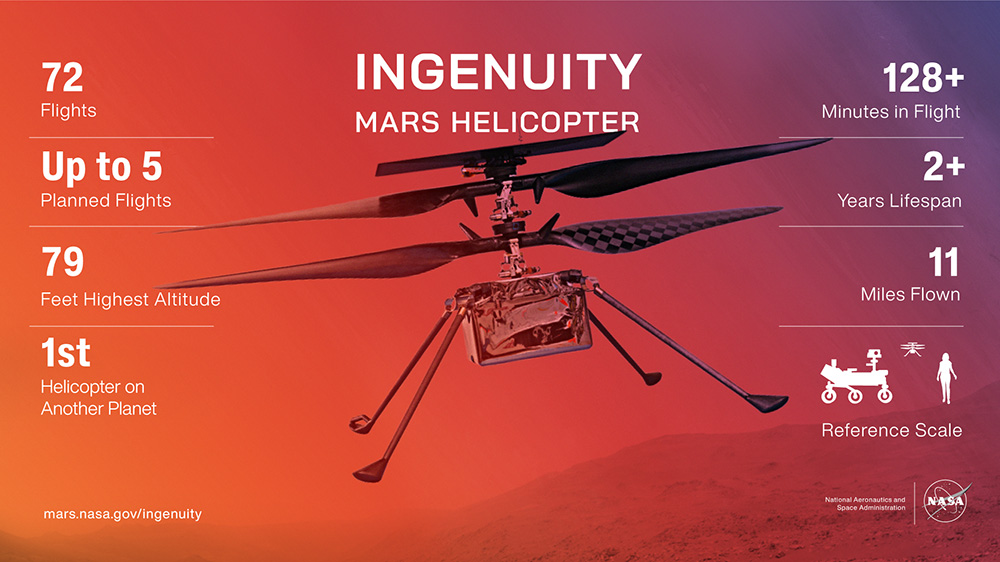After 72 flights, NASA says goodbye to Ingenuity helicopter

The Ingenuity helicopter achieved much in its nearly three years on Mars. | Source: NASA/JPL-Caltech
The Ingenuity helicopter, the first ever aircraft to fly on another planet, ended its nearly three-year journey on Mars, said NASA yesterday. The helicopter, originally intended as a technology demonstration, has surpassed all of NASA’s expectations and completed dozens more flights than originally planned.
While the Ingenuity remains upright and in communication with ground controllers, it will not be able to fly again. NASA received images of its Jan. 18 flight this week showing that one or more of its rotor blades had sustained damage during landing, making the helicopter no longer capable of flight.
“The historic journey of Ingenuity, the first aircraft on another planet, has come to end,” said NASA Administrator Bill Nelson in a release. “That remarkable helicopter flew higher and farther than we ever imagined and helped NASA do what we do best – make the impossible, possible. Through missions like Ingenuity, NASA is paving the way for future flight in our solar system and smarter, safer human exploration to Mars and beyond.”
On Jan. 18, Ingenuity’s team planned for the helicopter to make a short vertical flight to determine its location. The helicopter had executed an emergency landing on its previous flight, leaving NASA’s engineers unsure of exactly where it touched ground.
NASA’s data shows that, as it had planned, the helicopter rose to a maximum height of 40 ft. (12 m) and hovered for 4.5 seconds before starting its descent at a velocity of 3.3 feet per second (1 meter per second). At about 3 ft. (1 m) above the Martian surface, Ingenuity lost communication with the Perseverance rover, which serves as a communications relay for the helicopter.
Ingenuity’s team reestablished communications with the helicopter the following day, and NASA Jet Propulsion Laboratory (JPL) was able to gather more information about the flight. Several days later, new images showed that a rotor blade had been damaged.
The team is still investigating the cause of the communications dropout and the helicopter’s orientation when it touched down.
 Learn from Agility Robotics, Amazon, Disney, Teradyne and many more.
Learn from Agility Robotics, Amazon, Disney, Teradyne and many more.
Ingenuity survived the journey to Mars
When Ingenuity started its journey on Mars, strapped to the belly of the Perseverance rover, NASA hoped it would perform at least five experimental test flights over 30 days. It first lifted off the Martian surface on April 19, 2021, proving that powered, controlled flight on another planet was possible. It was not designed to carry payloads or execute other missions.
After completing its initial mission, Ingenuity became an operations demonstration. During this phase, it served as an aerial scout for Perseverance scientists and rover drivers. In 2023, the helicopter expanded NASA‘s knowledge of its aerodynamic limits when it completed two successful flight tests.
“At NASA JPL, innovation is at the heart of what we do,” stated Laurie Leshin, director of NASA JPL. “Ingenuity is an exemplar of the way we push the boundaries of what’s possible every day. I’m incredibly proud of our team behind this historic technological achievement and eager to see what they’ll invent next.”
Helicopter pushed the boundaries of flight on Mars
In the end, Ingenuity’s mission lasted almost 1,000 sols (Martian days or 24 hours, 39 minutes, 35 seconds), more than 33 times longer than NASA originally planned. Because of this, Ingenuity’s team had to constantly innovate to keep the helicopter running as long as possible.
While on Mars, Ingenuity was upgraded with the ability to autonomously choose landing sites in treacherous terrain. It also dealt with dead sensors, cleaned itself after dust storms, operated from 48 different airfields, performed three emergency landings, and survived a Marian winter.
The helicopter was only designed to survive during spring. To keep it running through the coldest parts of winter, Ingentity powered its heaters throughout the night. This, however, caused the flight computer to periodically freeze and reset. These power “brownouts,” as NASA called them, pushed the team to redesign Ingenuity’s winter operations to keep it up and running.
In its nearly three years on Mars, the Ingenuity helicopter performed 72 flights, flew more than 14 times farther than planned, and logged more than two hours of total flight time.
Now that flight operations have concluded, the Ingenuity team will perform final tests on the helicopter’s systems and download the remaining imagery and data in Ingenuity’s onboard memory. Right now, the Perseverance rover is too far away for it to capture images of the helicopter at its final airfield.
The post After 72 flights, NASA says goodbye to Ingenuity helicopter appeared first on The Robot Report.
from The Robot Report - Robotics News, Analysis & Research https://ift.tt/f0c2Iv1
via artificialconference

Comments
Post a Comment